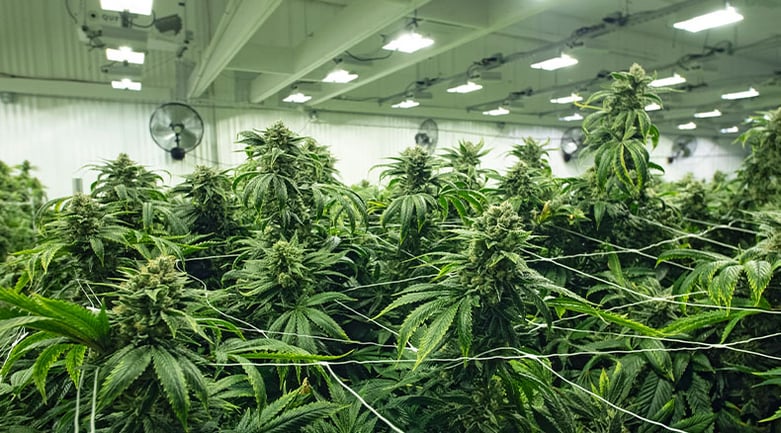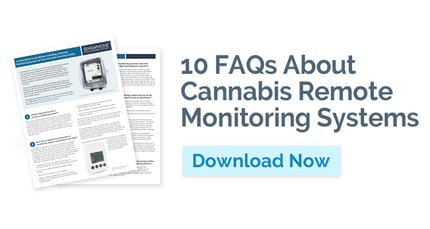
When growing cannabis, it’s important to maintain the best growing conditions to keep your plants alive and healthy. However, it’s not an easy task with the different factors that impact plant growth. A cannabis remote monitoring system provides the capability to track critical parameters within a facility to improve growing environments for optimum yield.
Manual tracking of environmental changes and equipment status within cannabis growing facilities is difficult and time-consuming. Temperature, humidity, CO2, and lighting are a few of the conditions that staff must continuously monitor. A cannabis remote monitoring system provides a high level of control over operations to protect plant inventory and support cultivation.
Monitor Critical Conditions
A healthy environment is critical to sustain plant development. Even small changes to environmental conditions can negatively impact cannabis plant yield. For example, temperature extremes can cause physical damage to plants, and excessive moisture can lead to mold and powdery mildew.
A cannabis remote monitoring system can detect problems such as temperature changes, humidity fluctuations, power outages, lighting low CO2, and unauthorized access.
Your staff can view real-time data online at any time. Whether on-site or off-site, they can obtain the status of all monitored conditions and equipment for immediate updates. Assigned personnel even can access trending reports, review alarm history, and review the status of multiple areas.
A cannabis remote monitoring system also can send instant notifications via email, phone call, or text message when conditions fall outside of your preset range. In addition, it can alert you about an unauthorized presence in the cannabis greenhouse. Alarm notifications are especially important after hours and or during the off-season when personnel may not be present in the facility.
Gain Historical Insights
In addition to tracking operations, a cannabis remote monitoring system, like the Sensaphone Sentinel, can function as a data logger in automatically recording tens of thousands of data points, dates, and times.The system provides unlimited storage and lets users view, graph, print, and export data.
Using this information, your managers can gain valuable insights on patterns and trends in environmental changes of cannabis growing operations to identify ways to optimize operations and prevent problems before they impact plant yields.
For example, if temperature increases gradually over an extended period, the change may not be noticeable. Since the data logger monitors trends, personnel can find out what areas or equipment might be causing these changes.
Data loggers also might show power fluctuations occurring at regular intervals or signs of a ventilation fan or lighting fixture beginning to malfunction. This information allows you to take action and repair or replace equipment before total failure.
Comparing temperatures and other environmental conditions from year to year can help growers determine optimal growing conditions for different areas of the facility. Moving forward, personnel can make adjustments to the environment to optimize plant health, production, and yield.
Selecting a Cannabis Remote Monitoring System
When choosing a cannabis remote monitoring system, consider the following factors:
- Base Units and Sensors
- Wireless or Hardwired sensors
- Communication Methods (phone, cellular, WiFi)
- Alarm Notification
- Programming and Status Checks
- Data Logging
- Return on Investment.
Base Units and Sensors
The selection of sensors depends on the number and type of conditions you want to monitor in your cannabis greenhouse. Conditions for monitoring also will determine the size of the remote monitoring system.
Typically, key conditions for monitoring include temperature, humidity levels, lighting, frost, water leaks, power failures, soil moisture, CO2 levels, irrigation and soil moisture, air circulation, and greenhouse security. Each condition requires its own sensor input on the base unit of the monitoring system. It is important that you select a system that has enough digital inputs to fit your needs.
For a smaller cannabis facility, the best option may be a lower-cost, non-expandable monitoring system. Larger facilities with many monitoring points and a larger staff who needs to access and receive information should invest in an expandable system that can grow with them. That way, you won’t have to replace the entire system in the future.
Additionally, your remote monitoring system should have an internal rechargeable battery backup to provide uninterrupted power during power failures. It is recommended to have each base unit sealed in an enclosure to protect it from moisture, dirt, and chemicals.
Wireless or Hardwired Sensors
A cannabis remote monitoring system is configurable with either hardwired sensors or wireless sensors. Hardwired sensors connect directly to the base unit using standard electrical wires. However, requirements for trenching wires can be time-consuming and expensive. The cost of installing hardwired sensors depends on several factors:
- Size of the monitored area
- Number of sensor installations
- How easy it is to access the internal network and cabling
A wireless system is ideal in areas where it is cost-prohibitive to wire sensors. With built-in radio transmitters that connect to a monitoring system, wireless sensors do not require running wiring through walls, floors, or ceilings. Expanding monitoring areas and conditions becomes quick and easy as you grow your operations and capabilities. Some remote monitoring systems can support a combination of hardwired and wireless sensors.
Communication Options
As landlines become obsolete and phased out by providers, most remote monitoring systems interface through an Internet connection that is commonly available in most business operations. Cellular options are available for locations without access to an Internet connection. However, remote monitoring systems using cellular communications must be registered on a wireless network before you can send or receive messages.
You will also need to ensure that there is sufficient signal strength at your facility. It is a good idea to check the signal quality in your area before purchasing a cellular product. For locations with improper coverage, an antenna can be used to strengthen the cellular signal. Sensaphone offers a variety of communication methods that address different application limitations and requirements.
Alarm Notifications
When choosing a cannabis remote monitoring system, consider how you want to set up alarm notifications. Monitoring systems immediately send an alert to designated personnel whenever they detect a threat to your facility. If you don’t want to send a notification to all personnel, some systems let you customize alarm functions to notify different people depending on the time of day or the specific issue.
Your system should provide multiple communication methods (e.g., email, phone, and text) and continue to make phone calls until someone responds. Also, consider the number of people the system can notify.
Programming and Status Check
If you’re responsible for maintaining a cannabis facility, you want a remote monitoring system that provides real-time status of all monitored equipment and conditions. There are a few different ways you can access sensor readings with monitoring systems. You can call in to check status, view a web page (either on a local network or the cloud), or open an app on your mobile device.
With a cloud-based system, you can monitor real-time status, make programming changes, and review data logs from anywhere. If you don’t select a cloud-based system, you will have to log in through a local area network to access status conditions.
Data Logging
As previously discussed, a remote monitoring system can function as a data logger in recording tens of thousands of data points, dates, and times useful in identifying patterns and trends in your cannabis operations. Using this information, you can identify problems or tweak operations to improve operation conditions.
Return on Investment
When deciding how much to pay for a remote monitoring system, add the entire cost (fully installed with additional equipment and sensors) and any installation fees. Then, compare that cost to the value of your plant inventory and growing equipment. Finally, consider the cost if you have an environmental issue that shuts down your operation for some time.
Purchasing a cannabis remote monitoring system is an important decision. Whatever system you choose, this device will provide an extra line of defense and control by continuously tracking the critical conditions of your facility. Whether on-site or off-site, you are always connected and aware of the critical conditions that threaten your property and plant inventory.
For tips on selecting a system for your facility, download 10 FAQs About Cannabis Remote Monitoring Systems, or contact a product expert today.








